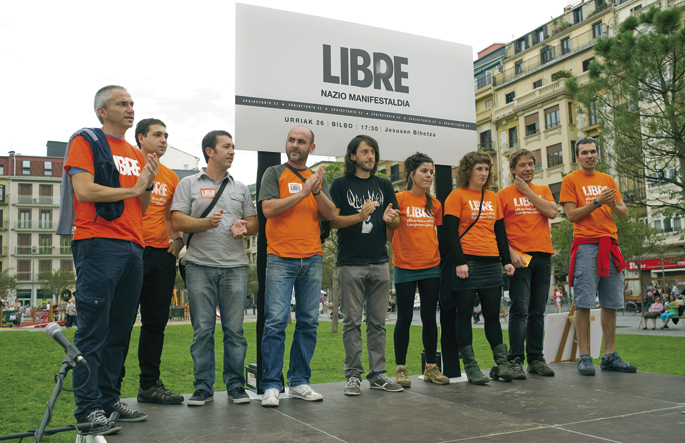

The demand for social personalities has claimed the freedom of the 40 young Basques tried in the National Court, who have been convicted. What is the main feature of the manifesto? The diversity of the people who demand it and which coincides with the atmosphere of dialogue and demand for peace after 11 January. Jesús Egiguren, Begoña Errazti, Ainhoa Aznarez, Mikel Aranburu, Rafaela Romero, Jose Mari Esparza, Toti Martinez de Lezea... They are the mirror of the claim being made by Basque society. It is well known that in another time and environment Spanish justice has given a certain kind of condemnation and in the current context the sentence should take a further step towards peace. Is that possible?
The participation in meetings of youth assemblies, street hearings, press conferences, the sale of t-shirts, the organization of Youth Meetings in which thousands of young people participate... has been one of those actions and therefore the prosecutor’s office has requested penalties of between 7 and 9 years, because for him they are all from Segi and because Segi is a youth organization within ETA. Everything is the last absurd vestige of the old ETA strategy, if the 2014 judgment batean.Baina was already untenable in 2005, much less in 2014, although then the Supreme Court put it on its head. The other 33 members of the 'Jarrai-Haika case', sentenced in 2005, were sentenced to between two and three years ' imprisonment for membership in the illegalized organization. The judgment, on the other hand, clearly indicated that they were not members of an armed organization, but members of ETA. For this reason, the sentence was ultimately left within a much shorter period than the 280 years required by the prosecution. Will something of this kind happen again? There may be a lot of arguments to think so. Why were Jarrai-Haika not members of the terrorist organisation and these accused of belonging to Segi? Although the Supreme later said yes, it did not make sense. Let us see if there is now a trace of the first judgment of 2005.
In addition, young people ' s lawyers have asked that statements of torture made in the police station ' s incommunication be disregarded and without them the prosecution ' s accusations are worthless. There would be a need for acquittal, but if this were too harsh for Spain, it might be thought that there could be some middle way between the two sides. Lawyers can jump up to 1999, when the Constitutional Court (TC) annulled the seven-year prison sentence imposed on members of the HB National Bureau, claiming it was disproportionate. It should be borne in mind that young defendants have already been in prison for between one year and two years, so they can go out on the street or soon with a penalty. The decade of these macrojudgments, which look like the witch hunt by Pierre de Lancre, has been long and hard. The results have been hard, dozens of people imprisoned for their political or business activity, like all those of 18/98. And after these 40 young people, the case of the Herriko Tabernas, which is still being tried, is there.
“We want to build bridges where the first walls were,” the signatories of the manifesto say. The image of the bridge is typical, perhaps too often used, but it does not stop being beautiful because it offers the possibility of moving from one side to the other without further ado. That is where more and more people are in Basque society, because simply the passing of the bridge benefits. Bridges are beautiful because in addition to linking the lands they can bring together times, and that's key to those who have been in trouble for a long time, whether it's a person or a village, because those who want to look to the future will have to get used to the back and forth of the past normally.